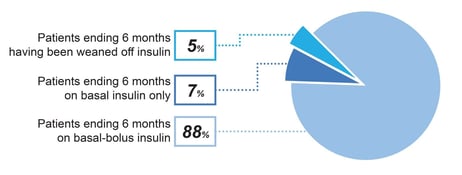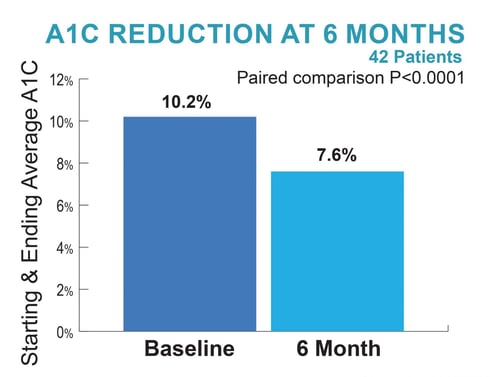Presentation
International Conference on Advanced Technologies & Treatments for Diabetes
Date
February 2017
Authors
Bruce Bode,1 John Clarke1
BACKGROUND
Treatment of diabetes with multiple daily injections (MDI), using a regimen of long-acting basal and rapid-acting bolus insulins, is widely accepted treatment; however, in the past MDI has been a complex and difficult treatment plan for providers to administer and for patients to follow. Glucommander is therapy management software intended to assist providers with insulin dose titration. It is a commercially available, cloud-based software solution that analyzes patient glucose data and calculates individualized insulin dose recommendations.
METHODS
The study was comprised of 42 patients who failed other therapies. The patient mix included both type 1 and type 2 diabetes. All patients had HbA1c measurements at the start of treatment and again at 3 and 6 months. The study was a paired before-and-after design. All insulin dose adjustments were calculated and recommended by Glucommander. Glucose data was collected using the Telcare, connected blood glucose meter, which was able to provide near real-time data in a secure cloud environment. Adjusted insulin doses from Glucommander were provided to a healthcare professional and then electronically sent to the patient.
| Study Characteristics | Parameter | ± σ |
|---|---|---|
| Number of Patients | 42 | |
| Median # Days until Day-averaged BG <180 for 3 consecutive days | 11 | |
| % BGs <3 mmol/L (54 mg/dL) | 0.2% | |
| % BGs <2.22 mmol/L (40 mg/dL) | 0.02% | |
| Number of BGs | 25940 | |
| Average # Tests/Day (first 3 months) | 2.9 | |
| Average # Tests/Day (last 3 months) | 1.9 |
| Insulin Doses | Parameter | ± σ |
|---|---|---|
| Average Initial TDD (units/kg) | 0.70 | 0.4 |
| Average Final TDD (units/kg) | 0.90 | 0.3 |
| Average Initial % of Basal Insulin | 51% | |
| Average Final % of Basal Insulin | 53% |
| Demographics | Parameter | ± σ |
|---|---|---|
| Average Age (years) | 59 | 13 |
| Male, n (%) | 29 (60.5%) | |
| Average Initial BMI (kg/m2) | 31.5 | 5.7 |
| Average Final BMI (kg/m2) | 32.4 | 5.8 |
| Change to Average BMI | 0.9 | 1.5 |
| Average Initial Weight (kg) | 95 | 21 |
| Average Final Weight (kg) | 97.6 | 47 |
| Change to Average Weight (kg) | 2.6 | 4.3 |
| DM type 2, n (%) | 34 (79%) | |
| DM type 1, n (%) | 9 (21%) | |
| Average Years with DM | 17.1 |
RESULTS
During treatment with Glucommander, HbA1c decreased from a baseline average of 10.2% to 7.7% at 3 months and 7.6% at 6 months. The baseline-to-final HbA1c decrease shows a P <0.00001 by paired T-test. Hypoglycemia was infrequent throughout (see table). Out of 25,940 BGs, the average number of BG tests per day was 2.9 during the first 3 months and 1.9 during the final 3 months. The median time for patients to achieve three consecutive days with their average daily BGs <10 mmol/l (180 mg/Dl) was 11 days. As a backup check the mean BG was tested also; it declined from 14.8 to 9.2 mmol/l with P <0.00001. This drop is free from Regression-Toward-the-Mean.
CONCLUSION
The sustained use of Glucommander is effective and easy for providers. It was associated with few instances of hypoglycemia. Prospective randomized clinical trials are ongoing to compare the safety, efficacy and cost of Glucommander versus other outpatient diabetes management methods. Diabetes therapy management software that provides personalized patient recommendations can substantively improve clinical outcomes and assist providers in getting more patients to goal.
AFFILIATIONS
- Atlanta Diabetes Associates, Atlanta, Georgia.




